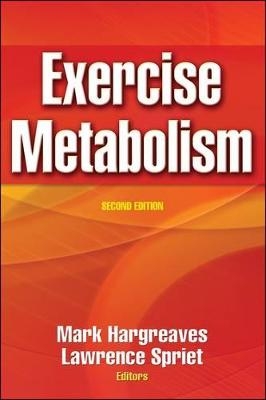
Exercise Metabolism
Human Kinetics (Verlag)
978-0-7360-4103-4 (ISBN)
- Titel ist leider vergriffen;
keine Neuauflage - Artikel merken
Exercise Metabolism, Second Edition, provides a systematic, in-depth examination of the regulation of metabolic processes during exercise. Exercise physiologists, exercise biochemists, and biochemists will find this book a comprehensive reference, using the up-to-date information and the nearly 1,000 references in their own research and writing. In addition, graduate students in these disciplines can learn firsthand about the various regulations of metabolic processes during exercise as they prepare for careers in exercise physiology or biochemistry.
Written by internationally recognized researchers, Exercise Metabolism, Second Edition, is both revised and expanded while retaining the essential elements of the first edition. It delves into the mobilization and utilization of substrates—glucose, lipid, and protein—during physical activity, and it explores metabolic factors in fatigue and metabolic adaptations to endurance training.
Chapter 1 provides an overview of exercise metabolism. Metabolism during high-intensity exercise and the transition from rest to exercise are covered in chapter 2, which details the so-called anaerobic energy pathways. Chapter 3 discusses the effects of exercise on carbohydrate metabolism in skeletal muscle, while chapter 4 provides an overview of the important metabolic functions of the liver during exercise.
Chapter 5 is a new chapter that addresses lactate transport in skeletal muscle, given the increased understanding of this topic since the first edition was published. Chapters 6 and 7 summarize the effects of exercise on lipolysis in adipose tissue and lipid metabolism in skeletal muscle, respectively. The contribution of protein and amino acids to exercise metabolism is discussed in chapter 8. Finally, metabolic factors in fatigue and the metabolic adaptations to endurance training are reviewed in chapters 9 and 10, respectively. Chapter-ending summaries help to condense the information and facilitate understanding.
Exercise Metabolism, Second Edition, is a valuable reference to exercise physiologists, exercise biochemists, and biochemists, and it serves as an ideal text for graduate students in these disciplines.
Mark Hargreaves, PhD, returns as editor of this edition of the book. He has more than 20 years of research experience in exercise physiology and metabolism and has published numerous papers on exercise metabolism. He is a physiology professor at the University of Melbourne in Australia, where he earned his PhD in physiology in 1989. His master's degree, in exercise physiology, is from Ball State University in Muncie, Indiana. Dr. Hargreaves was honored by the American College of Sports Medicine with a 1994 New Investigator Award. Also in 1994, he was awarded the McIntyre Prize by the Australian Physiological and Pharmacological Society. Lawrence Spriet, PhD, is a professor in the human biology and nutritional sciences department at the University of Guelph. For 19 years he has been a researcher in the area of whole-body and skeletal muscle metabolism; he has received funding from the Natural Sciences and Engineering Research Council of Canada and the Canadian Institutes of Health Research. Dr. Spriet is a member of the American and Canadian Physiological Societies, American College of Sports Medicine, and the Canadian Society for Exercise Physiology. He has been an editorial board member or associate editor of numerous research journals in the field. He earned his doctorate degree at McMaster University in Hamilton, Ontario.
Chapter 1. Overview of Exercise Metabolism
Lawrence L. Spriet, PhD, and Mark Hargreaves, PhD
-Metabolic Fuels and Rates of ATP Production
-Control of Metabolic Pathways
-Signals Matching ATP Synthesis and ATP Demand
Chapter 2. Anaerobic Metabolism During Exercise
Lawrence L. Spriet, PhD
-Skeletal Muscle ATP Concentration Is Defended During Exercise
-Importance of Anaerobic Metabolism
-Sources of Anaerobic ATP
-Regulation of Anaerobic Energy Provision
-Carbohydrate
-Phosphocreatine
-Intermittent High-Intensity Exercise
-Anaerobic Metabolism at the Onset of Exercise
-Summary
Chapter 3. Skeletal Muscle Carbohydrate Metabolism During Exercise
Mark Hargreaves, PhD
-Muscle Glycogenolysis and Glucose Uptake During Exercise
-Regulation of Muscle Glycogenolysis
-Regulation of Muscle Glucose Uptake
-Regulation of CHO Oxidation
-Lactate Metabolism
-Postexercise CHO Metabolism
-Summary
Chapter 4. Hepatic Metabolism During Exercise
Michael Kjï¿œr, MD
-Hepatic Glucose Output During Exercise: Glycogenolysis and Gluconeogenesis
-Feedback Regulation of Hepatic Glucose Output
-Feed-Forward Regulation of Hepatic Glucose Output
-Regulatory Hormonal and Neural Mechanisms in Hepatic Glucose Production
-Hepatic Uptake of Gluconeogenic Precursors
-Summary
Chapter 5. Skeletal Muscle Lactate Transport and Transporters
Arend Bonen, PhD
-Lactate Transport System
-Lactate Transport Proteins
-MCT1 and MCT4 in Human Skeletal Muscle
-Subcellular Distribution of MCT1 and MCT4 in Muscle
-MCT1 and MCT4 Transporters and Lactate Transport
-Effects of Training on MCT1 and MCT4
-Possible Roles of MCTs
-Summary
Chapter 6. Adipose Tissue Lipid Mobilization During Exercise
Jeffrey F. Horowitz, PhD
-Regulation of Lipolysis in Adipose Tissue
-Regional Lipolysis
-Measuring Lipolysis in Vivo
-Regulation of Adipose Tissue Blood Flow
-Other Triglyceride Sources
-Lipolytic Response During Endurance Exercise
-Endurance Exercise Training
-Summary
Chapter 7. Skeletal Muscle Lipid Metabolism During Exercise
Lorraine P. Turcotte, PhD
-Plasma Long-Chain Fatty Acid Metabolism
-Muscle Triacylglycerol Metabolism
-Plasma Triacylglycerol Metabolism
-Summary
Chapter 8. Effect of Exercise on Skeletal Muscle Protein and Amino Acid Metabolism in Humans
Martin J. Gibala, PhD
-Protein Turnover and Exercise
-Skeletal Muscle Amino Acid Metabolism During Exercise
-Influence of Protein or Amino Acid Ingestion on Muscle Adaptation During Recovery
-Summary
Chapter 9. Metabolic Factors in Fatigue
Kent Sahlin, PhD
-Limits of Energetic Processes
-Central Fatigue
-Peripheral Fatigue
-Integrated View of Fatigue During Static and Dynamic Exercise
-Summary
Chapter 10. Endurance Training-Induced Adaptations in Substrate Turnover and Oxidation
Stuart M. Phillips, PhD
-Study Design Considerations
-Effect of Training on Substrate Turnover and Oxidation
-Underlying Mechanisms of Training-Induced Adaptations
-Summary
| Erscheint lt. Verlag | 16.12.2005 |
|---|---|
| Verlagsort | Champaign, IL |
| Sprache | englisch |
| Maße | 152 x 229 mm |
| Gewicht | 612 g |
| Themenwelt | Medizin / Pharmazie ► Medizinische Fachgebiete ► Sportmedizin |
| Studium ► 1. Studienabschnitt (Vorklinik) ► Physiologie | |
| ISBN-10 | 0-7360-4103-6 / 0736041036 |
| ISBN-13 | 978-0-7360-4103-4 / 9780736041034 |
| Zustand | Neuware |
| Haben Sie eine Frage zum Produkt? |
aus dem Bereich


